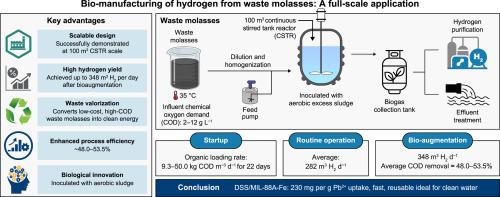废糖蜜氢的生物制造:全面应用
IF 14.3
1区 环境科学与生态学
Q1 ENVIRONMENTAL SCIENCES
引用次数: 0
摘要
产酸发酵生物制氢是一种很有前途的可持续制氢途径;然而,关于其全面应用的数据仍然有限。在这里,我们评估了一个100立方米的连续流搅拌槽反应器(CSTR)的性能,该反应器利用废糖蜜并接种好氧剩余污泥用于制氢。反应器运行温度为35℃,水力停留时间为5.8 h,有机负载率(OLR)由9.3 kg COD m−3 d−1逐步提高到57.3 kg COD m−3 d−1。到第19天,建立了稳定的乙醇型发酵,平均每天产生265 m3的氢气。在随后的72天里,反应器保持连续运行,平均产氢率为282 m3 d - 1,平均OLR为28.5 kg COD m - 3 d - 1。以相对于混合液挥发性悬浮物的0.5%体积分数添加乙醇寡聚烯habinense YUAN-3,进一步提高了产氢量,平均达到348 m3 d - 1。尽管OLR在17.1和55.2 kg COD m - 3 d - 1之间波动,但乙醇型发酵在整个生物增强期持续存在。这些发现证明了大规模产酸发酵从高强度有机废水中高效制氢的可行性。本文章由计算机程序翻译,如有差异,请以英文原文为准。

Biomanufacturing of hydrogen from waste molasses: A full-scale application
Biomanufacturing of hydrogen by acidogenic fermentation presents a promising avenue for sustainable hydrogen production; however, data on its full-scale application remain limited. Here we evaluate the performance of a 100 m3 continuous-flow stirred-tank reactor (CSTR) utilizing waste molasses and inoculated with aerobic excess sludge for hydrogen production. The reactor operated at 35 °C with a constant hydraulic retention time of 5.8 h, while the organic loading rate (OLR) was incrementally increased from 9.3 to 57.3 kg COD m−3 d−1. By day 19, stable ethanol-type fermentation was established, yielding an average of 265 m3 of hydrogen per day. Over the subsequent 72 days, the reactor maintained continuous operation, achieving an average hydrogen production rate of 282 m3 d−1 at an average OLR of 28.5 kg COD m−3 d−1. Bioaugmentation with Ethanoligenens harbinense YUAN-3 at a 0.5 % volume fraction relative to the mixed liquor volatile suspended solids further enhanced hydrogen production to an average of 348 m3 d−1. Despite fluctuations in the OLR between 17.1 and 55.2 kg COD m−3 d−1, ethanol-type fermentation persisted throughout the bioaugmentation period. These findings demonstrate the viability of full-scale acidogenic fermentation for efficient hydrogen biomanufacturing from high-strength organic wastewater.
求助全文
通过发布文献求助,成功后即可免费获取论文全文。
去求助
来源期刊

Environmental Science and Ecotechnology
Multiple-
CiteScore
20.40
自引率
6.30%
发文量
11
审稿时长
18 days
期刊介绍:
Environmental Science & Ecotechnology (ESE) is an international, open-access journal publishing original research in environmental science, engineering, ecotechnology, and related fields. Authors publishing in ESE can immediately, permanently, and freely share their work. They have license options and retain copyright. Published by Elsevier, ESE is co-organized by the Chinese Society for Environmental Sciences, Harbin Institute of Technology, and the Chinese Research Academy of Environmental Sciences, under the supervision of the China Association for Science and Technology.
 求助内容:
求助内容: 应助结果提醒方式:
应助结果提醒方式:


